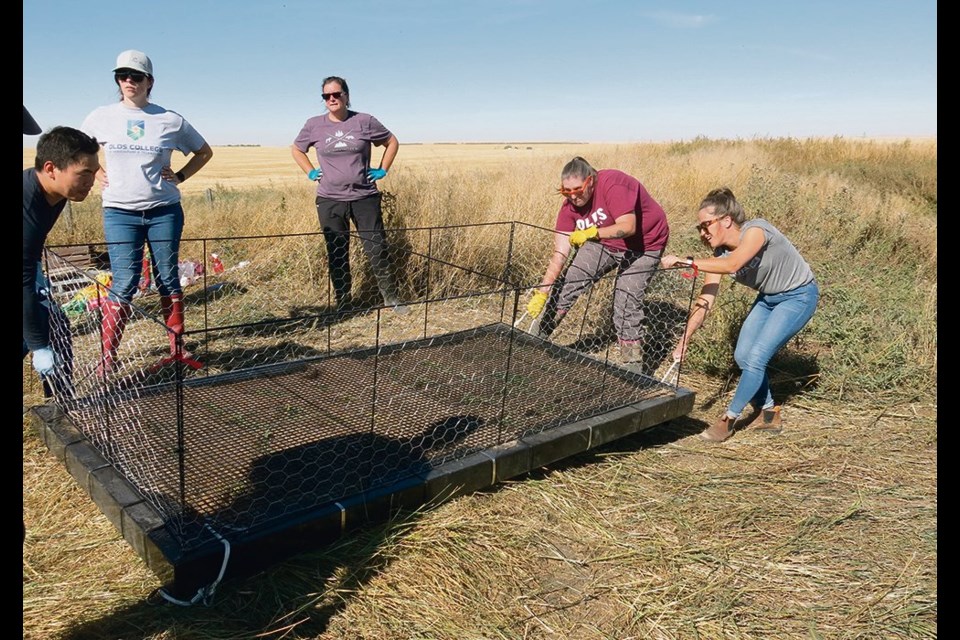OLDS, Alta. — The ability of man-made floating islands to control odour and contaminants in feedlot holding ponds is being tested in Alberta.
Scientists are researching the ability of the islands, which are planted with vegetation, to remove smells, antibiotics and heavy metals.
“This is really exploiting what nature does best to improve water quality,” said Daniel Karran, a faculty instructor and research scientist at Olds College in Alberta.
Such processes involving vegetation occur naturally in wetlands, he said, “and that’s why wetlands are valuable because of the ecosystem services that they provide, and so we’re trying to basically exploit those natural processes in another way and improve the water that’s on site in these operations.”
The technology is owned by Steven Tannas, president of Tannas Conservation Services Ltd. near Calgary. It is already used in mining and in some urban storm water ponds, said Karran.
The rectangular rafts of vegetation in the study are about 1.4 by 2.6 metres in size. The perimeter is made of a buoyant plastic material and the interior has a mix of soil media that Tannas has identified as optimal for plants, said Karran.
Different plant species are selected based on the contaminants targeted by researchers. Alberta feedlots are required to build holding ponds to contain runoff from precipitation and prevent it from polluting nearby properties or surface water.
The runoff typically contains manure, nitrogen and phosphorus that can cause eutrophication and harmful algal blooms in water, said Karran.
“You’ve got a lot of pathogens. You’ve got E. coli, cryptosporidium, salmonella.”
It also contains heavy metals ranging from copper and iron to aluminum, along with antibiotics and chemicals used in feedlots, he said.
“But our primary focus is really looking at the nutrient runoff that comes off of those feedlots, which is usually very high in sodium and bicarbonate and total dissolved solids, and those are contaminants that make it unsuitable for irrigation.
“It can be harmful to crops … and so the focus is really are those islands going to improve the water such that it can be reused for different operations at the feedlot.”
Holding ponds can emit foul odours that can affect nearby residences and communities. Such ponds at the Rimrock Feeders feedlot are suspected to be the source of a smell that has sparked complaints in the town of High River, Alta., south of Calgary.
The advantage of floating islands “is that you’re covering the surface area of the pond that typically wouldn’t be covered with plants,” said Karran. “And what happens is the roots go through the soil media and they go into the ponds, and the roots take up all those contaminants.”
They also help transport oxygen from the atmosphere into the water.
“These ponds are extremely unhealthy ecosystems and the fact is that they have no oxygen because when you dump a bunch of biomass into water, the bacteria that degrades the biomass needs oxygen.”
Plant growth is a passive process that requires little energy or maintenance by producers, which is another advantage.
“If you are trying to remove heavy metals, you might need to harvest the biomass every year and do away with that, but in some cases, you can just kind of leave them be year after year.”
The research project began in 2018 and has included testing of the floating islands within tanks in greenhouses at the college, said Ike Edeogu, manager of crops and environmental stewardship at the Olds College Centre for Innovation. The tanks contained diluted water from the college’s feedlot, he said.
The current third phase of the project involves floating islands recently placed in holding ponds at two commercial feedlots near the village of Linden, north of Acme, Alta. Cages have been placed on the islands to prevent waterfowl from nesting on them, said Karran.
“Our hope is that if we can use the plants to treat the water, then we’re not limited with what the water can be used for in the future,” said Edeogu.
Although it currently can only be used in a limited way on crops, water quality could potentially be improved so it can be used on vegetables that are eaten fresh, he said, and could also provide drinking water for cattle at feedlots.
“So, now all of a sudden a (feedlot) industry that was kind of limited to certain parts of the province can begin to expand into other areas where water is truly limited because now you can use all your water.”
Water from feedlot holding ponds is rarely used for irrigation or livestock now because of poor quality, said Karran.
“And so, I think it just sits there and evaporates for the most part.”

